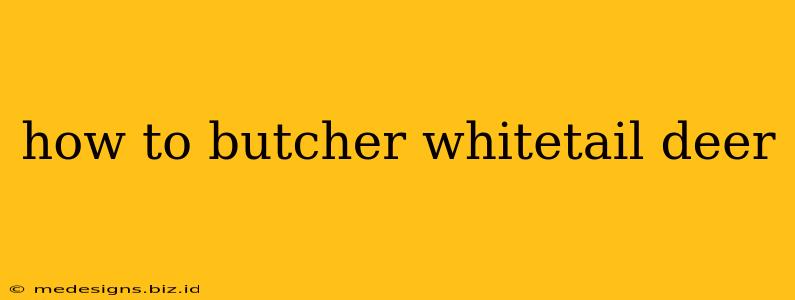Harvesting a whitetail deer is a rewarding experience, but the work doesn't end in the field. Properly butchering your deer ensures you get the most out of your hunt, providing delicious meat for months to come. This comprehensive guide will walk you through the process, from field dressing to packaging your venison.
Essential Tools for Butchering Whitetail Deer
Before you begin, gather these essential tools:
- Sharp Knives: You'll need a variety of knives, including a gutting knife (with a stiff blade), a boning knife (flexible blade), and a skinning knife (a smaller, pointed blade is ideal). Sharp knives are crucial for efficiency and safety. Dull knives increase the risk of injury and make the process much more difficult.
- Game Shears: These are invaluable for cutting through bone.
- Cutting Board: A large, sturdy cutting board will make the process much easier and cleaner.
- Gloves: Protect yourself from bacteria and potential cuts.
- Plastic Bags or Vacuum Sealer: Proper storage is essential for preserving your venison.
- Coolers: Keep your meat cold throughout the butchering process. Plenty of ice is crucial.
- Gambrel (Optional): A gambrel makes hanging the deer easier, facilitating easier skinning and quartering.
Field Dressing Your Whitetail Deer
Field dressing your deer as soon as possible after the harvest is critical for meat quality. Here's how:
- Safety First: Always be mindful of your surroundings and the position of your knife.
- Gutting: Make a cut from the sternum to the anus, being careful not to puncture the intestines. Remove the entrails carefully, ensuring no spillage into the meat.
- Washing: Rinse the cavity with cold water.
- Cooling: Get the deer to a cool place as quickly as possible.
Butchering Your Whitetail Deer: A Step-by-Step Process
After field dressing, you're ready for the main butchering process. This is best done in a clean, cool environment.
- Hanging the Deer: Hanging the deer allows for better drainage and makes butchering easier. Use a gambrel to hang the deer from its hind legs. Let it hang for at least 24 hours, preferably 3-5 days for aging (in a cool environment).
- Skinning: Start at the brisket, using your skinning knife to carefully separate the hide from the meat. Work your way up the legs, and then the back.
- Quartering: Cut the deer into quarters: two front shoulders and two hindquarters.
- Boning: Using your boning knife, carefully separate the meat from the bones. This requires patience and a steady hand. Pay attention to where the different muscles are and trim away the silver skin.
- Trimming: Trim away any excess fat or connective tissue.
- Packaging: Cut the meat into manageable portions for storage. Vacuum sealing is the best method for long-term storage, but freezer bags will also work.
Tips for Success
- Sharp Knives are Key: Dull knives are dangerous and make the process much harder.
- Hygiene is Crucial: Maintain a clean work area to prevent bacterial contamination.
- Take Your Time: Rushing the process can lead to mistakes and injuries.
- Learn from Experienced Hunters: If possible, watch an experienced hunter butcher a deer before attempting it yourself. This is invaluable for hands-on learning.
- Consider Butchering Services: If you're uncomfortable butchering your own deer, many processors offer this service for a fee.
Storing Your Venison
Proper storage is essential for keeping your venison fresh and safe to eat. Vacuum sealing is recommended for long-term storage, allowing for freezing up to a year. Frozen venison should be stored at 0°F (-18°C) or lower.
By following these steps, you can confidently butcher your whitetail deer and enjoy the fruits of your labor for many months to come. Remember safety and cleanliness are paramount throughout the entire process. Happy hunting!
